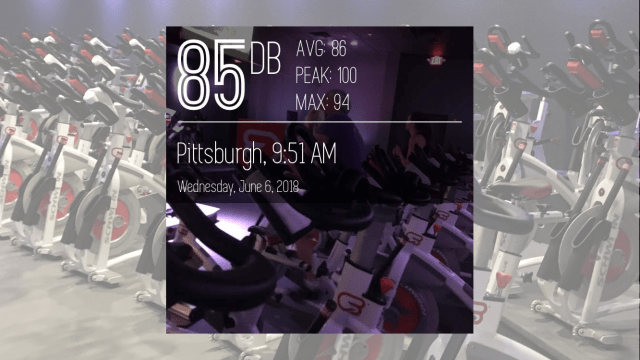When I walk into my local cycling studio, the music is at a level that’s easy to talk over. But once the instructor clips in, the volume goes way up. The sound fills your ears, so you can’t hear the person next to you breathing heavy. You feel like you’re inside the song, which helps you to really feel its energy. Perfect volume, right?
But depending on the studio (and how close you are to the speakers), it might be too loud. Way too loud. As Julia Belluz writes at Vox, cycling classes are sometimes above the US National Institute for Occupational Safety and Health’s standards for safe levels of noise exposure. The allowable levels are:
- 85 decibels (dBA) for an eight-hour workday
- 88 dBA for four hours
- 91 dBA for two hours
- 94 dBA for one hour
- 97 dBA for half an hour
- 100 dBA for 15 minutes
For comparison, a quiet room is 20-30 dBA, conversation is 60 dBA, and a nightclub with music is around 110 dBA. Decibels are logarithmic, so a small increase in the number represents a large increase in loudness. The measurements here are in A-weighted decibels, which are adjusted to match the way our ears detect sound.
A 2016 study of noise levels in cycling classes found that the average 45-minute class was nine times the allowable level for an eight-hour workday. This sounds like a lot, but it works out to 94 decibels, which has a limit of one hour.
That’s fine for people who just take that class and leave, but if the instructor (or multi-class riders) is there for several classes, they’re at risk for damaging their hearing. And since that’s an average, some classes are even louder.
To find out how loud your fitness class is, you can download an app. Your phone isn’t as accurate as a dedicated, calibrated noise meter, but it can give a pretty good approximate measurement.
I have two favourites: NIOSH’s Sound Level Meter (free, iOS), which calculates how the sound you’re measuring compares to the safe levels above, and Decibel X Pro ($3.49 on Android, $7.99 on iOS), which can create Instagram-ready images summarising the noise data and where it was collected. There’s also a free version of Decibel X that just measures unweighted decibels (dB, not dBA).
Give these apps a try if you’d like to find out whether your class is really too loud. I measured the sound at 86 dBA during the first half of class with one app, and 78 during the second half with another. That’s loud but not unsafe. Yours may be louder, though: Download an app and find out for yourself.

Comments